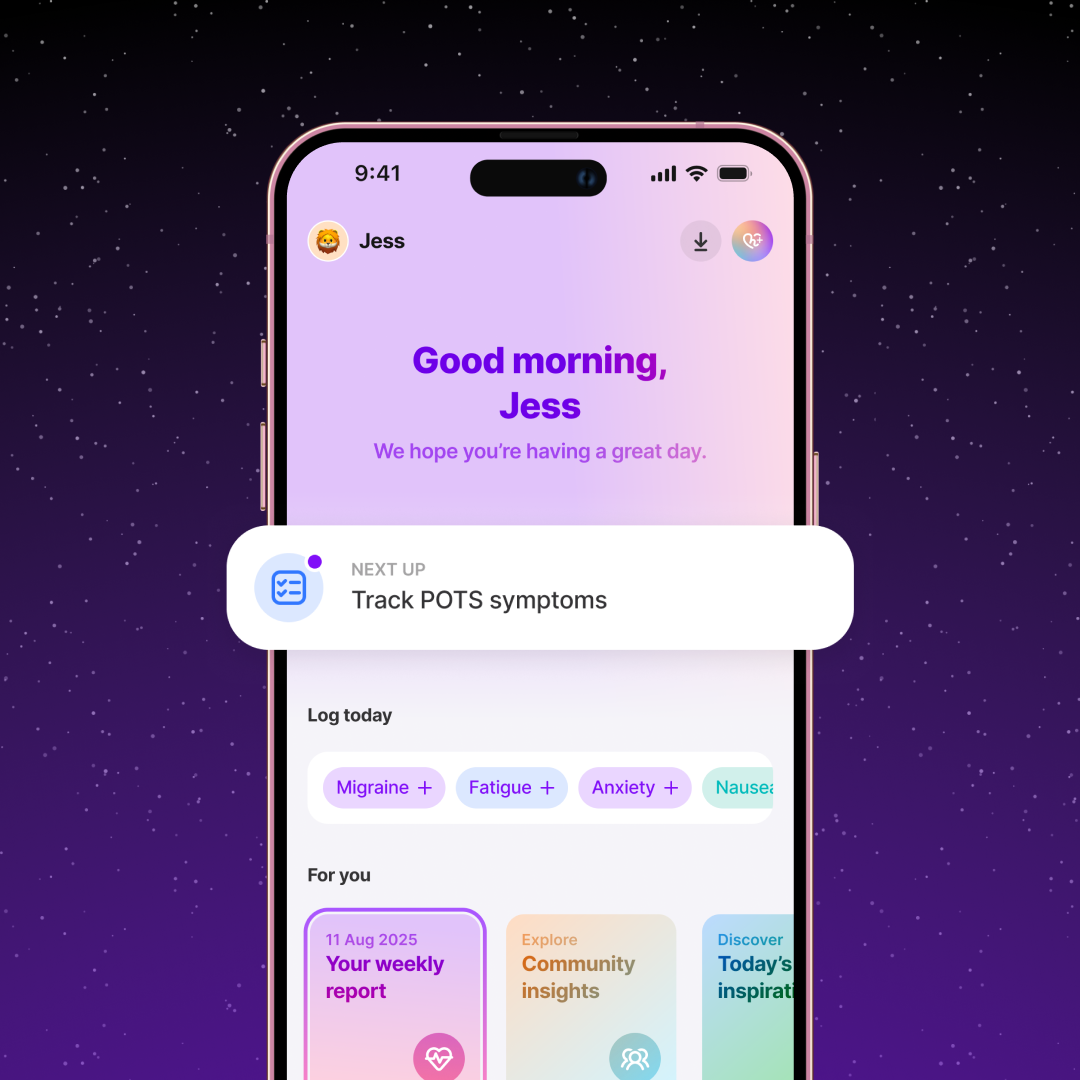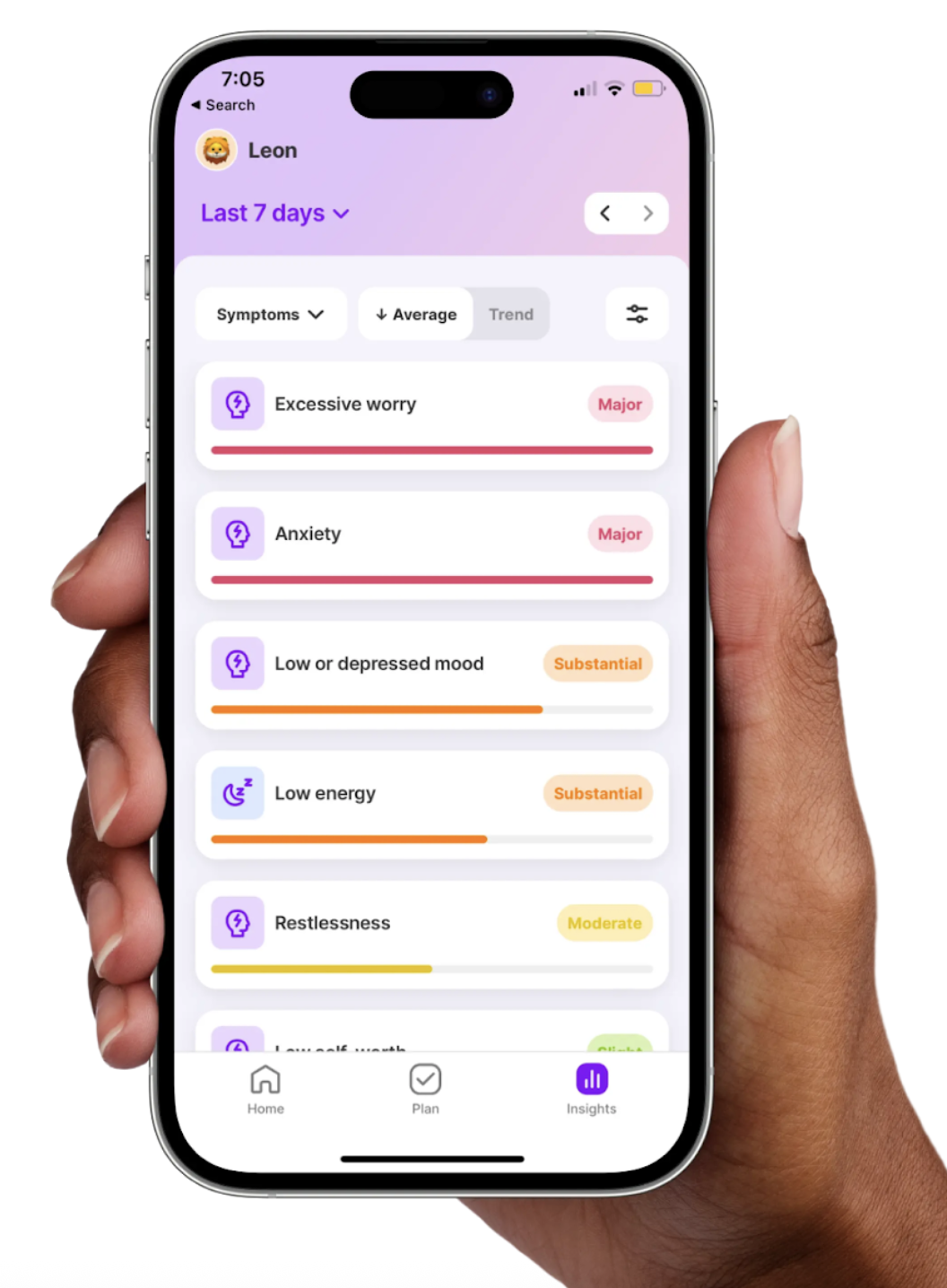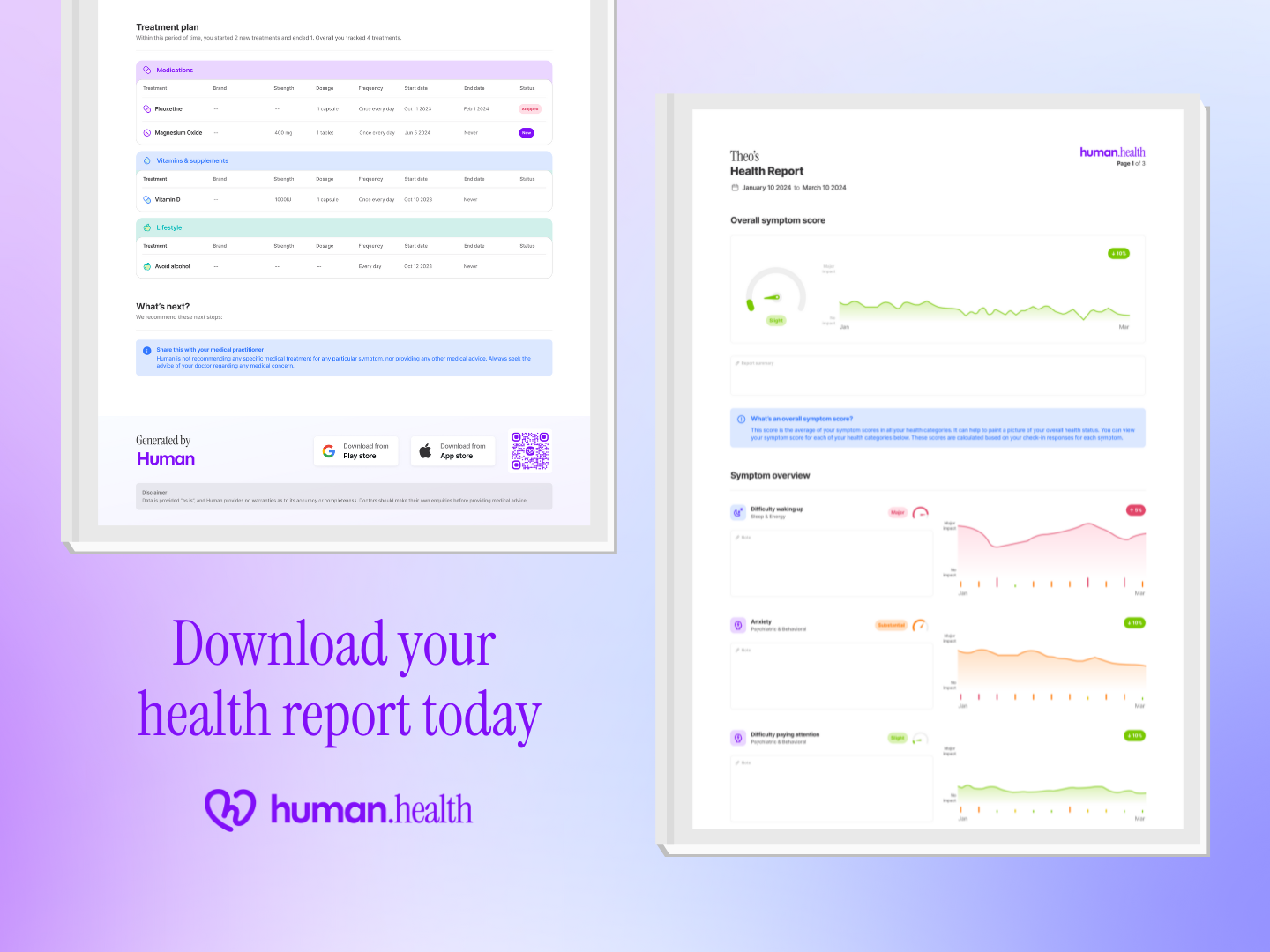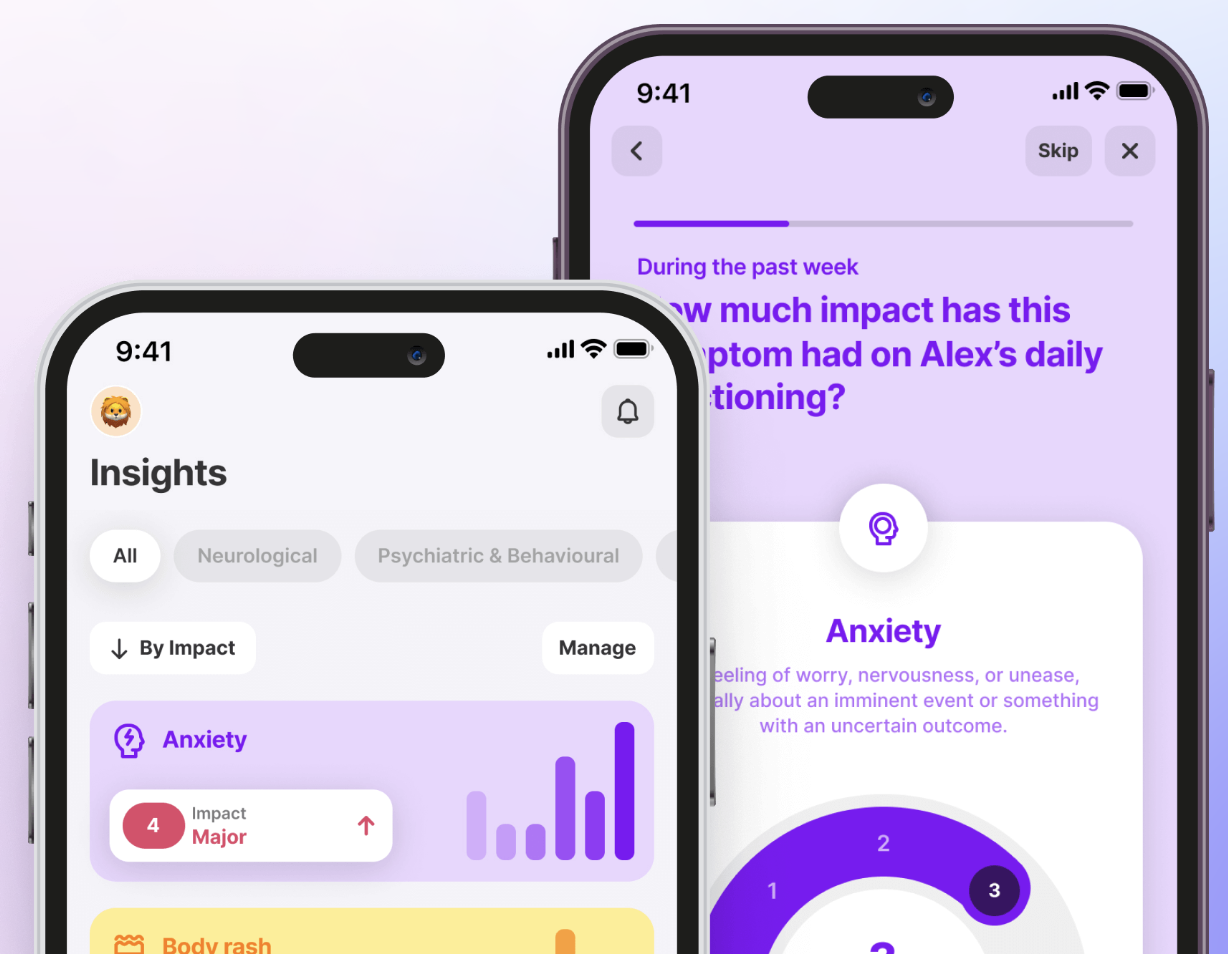POTS and EDS: Shared Symptoms, Differences & More
October 1, 2025

- POTS (Postural Orthostatic Tachycardia Syndrome) and Ehlers-Danlos Syndrome (especially the hypermobile type, hEDS) are closely connected: Research shows that many people with hEDS also experience POTS, highlighting how strongly the two conditions overlap.
- Shared symptoms include dizziness, fatigue, and joint-related issues: Human Health’s Symptom Tracker can help you log and identify trends in these overlapping experiences.
- Key differences matter: EDS primarily affects connective tissues, while POTS relates to blood circulation and heart rate changes.
- Diagnosis is complex and often delayed: Tracking your daily health data can support clearer conversations with healthcare providers.
Disclaimer: Human Health is a health tracking platform and does not provide medical advice, diagnosis, or treatment. The information in this article is intended to support, not replace, conversations with qualified healthcare professionals.
If you’ve ever felt your heart race just from standing up, or pushed through bone-deep fatigue alongside constant joint pain, you know how exhausting it is to search for answers. Many people living with postural orthostatic tachycardia syndrome (POTS) or Ehlers-Danlos syndrome (EDS) face this daily challenge.
Research shows a strong link: around one in three people with POTS also meet criteria for hypermobile EDS, while up to 80% of those with hEDS experience POTS.
In this article, you’ll learn how POTS and EDS overlap, what sets them apart, and what current research says about diagnosis and management.
We’ll also show how tracking symptoms with the Human Health app can help you spot patterns and bring clearer insights to conversations with your healthcare provider.
The link between POTS and EDS
Researchers have found a strong association between POTS and hypermobile Ehlers-Danlos Syndrome (hEDS), the most common EDS subtype. In one study, about 31% of people with POTS met criteria for hEDS, and additional patients showed joint hypermobility without a full hEDS diagnosis.
The exact cause of the overlap between hEDS and POTS isn’t fully understood, but ongoing research continues to explore how connective tissue differences might influence circulation and autonomic function.
Possible shared symptoms of POTS and EDS
POTS and hEDS may present with similar day-to-day challenges, which can make them hard to untangle.
Dizziness and lightheadedness
Both POTS and hypermobile Ehlers-Danlos syndrome (hEDS) can cause dizziness and lightheadedness when standing. In POTS, it happens because the heart races after standing up. In hEDS, it often shows up alongside POTS, making the two conditions feel closely connected.
Fatigue
Persistent fatigue is a well-documented symptom in POTS and is also frequently reported by people with hypermobile Ehlers-Danlos syndrome, particularly when the two conditions overlap.
Research highlights not only physical exhaustion but also sleep problems and cognitive difficulties often described as “brain fog.”
Tracking your daily energy levels in our symptom tracker can reveal how sleep, activity, or stress may contribute to your fatigue.

Joint pain and instability
EDS often leads to hypermobile joints, which can cause pain and frequent flare-ups. In certain forms of POTS, especially low-flow POTS, reduced blood flow to the muscles is linked to decreased muscle mass and weaker muscle pump function, which may contribute to muscle weakness and related discomfort.
Digestive Issues
Both Ehlers-Danlos syndrome (particularly the hypermobile type) and POTS are strongly linked with gastrointestinal problems, including reflux, bloating, nausea, abdominal pain, and altered bowel habits.
While it can be difficult to separate which condition is driving them, consistent tracking in the Human Health app helps capture frequency and severity, giving clearer insights into how your body responds over time.
Key differences of POTS vs. EDS
Despite overlap, POTS and hEDS affect the body in distinct ways.
Core cause
Ehlers-Danlos syndrome (EDS) is a group of connective tissue conditions caused by changes in collagen, the protein that gives strength and flexibility to skin, joints, and blood vessels. This can lead to overly flexible joints, fragile skin, and other structural problems.
Postural orthostatic tachycardia syndrome (POTS), on the other hand, is a problem with the body’s automatic functions: when you stand up, your heart rate rises much more than normal, often because blood pools in the lower body instead of circulating properly.
Symptom onset
POTS symptoms often appear when changing posture — for example, moving from sitting to standing. EDS symptoms, by contrast, tend to be more consistent, with joint pain, instability, or hyperextensible skin often noticeable much of the time. The Human Health app’s Symptom Tracker can help highlight these situational differences when you log daily experiences.
Treatment focus
Management strategies differ: EDS care often centers on joint support, physical therapy, and lifestyle adjustments, while POTS care focuses more on circulation, hydration, and heart rate management. Using the Human Health app’s treatment tracker helps keep both approaches organized in one place for those navigating overlapping treatments.
Recognizing these differences is key to better conversations about diagnosis and support.
Can I have both POTS & EDS?
Yes, it’s possible to have both conditions at the same time, and research shows they often go hand in hand.
Around 20–30% of people with POTS also meet criteria for hypermobile EDS or a hypermobility spectrum disorder. Looking the other way, studies suggest that about 41–49% of people with hEDS also experience POTS or another form of orthostatic intolerance. Some smaller studies have reported even higher numbers (up to around 80%), but those findings are preliminary and not consistently replicated. This overlap highlights how closely the two conditions are linked.
Because symptoms can be confusing and sometimes mimic each other, people may not realize they’re living with both. Tracking symptoms daily in the Human Health app can help you and your care team see the bigger picture, making it easier to discuss concerns and pursue the right testing or support.
If you’ve noticed signs of joint hypermobility, dizziness, or fatigue and are curious how they might relate to each other, you can take the Hypermobile Ehlers-Danlos (hEDS) Quiz to reflect on your symptoms and learn more about how hEDS and POTS can overlap before your next appointment.
{{inline-cta-1}}
How is POTS and EDS diagnosed today? What the studies say
Diagnosis often takes time because symptoms overlap with many other conditions.
POTS
POTS is typically diagnosed when a person’s heart rate increases significantly (often 30+ beats per minute) within 10 minutes of standing, without a major drop in blood pressure.
Diagnosis: What research shows
Research highlights consistent testing methods but also notes frequent misdiagnosis due to overlapping symptoms with other conditions. Logging episodes in the Human Health app’s Symptom Tracker can help provide clearer data during evaluations.
- Tilt table test is a common diagnostic tool.
- Heart rate and blood pressure are monitored while changing posture.
- Symptoms like dizziness and palpitations support the diagnosis.
- Studies show diagnostic delays, with many patients waiting years for clarity.
EDS
EDS is usually identified through clinical evaluation, family history, and physical signs such as joint hypermobility, mildly hyperextensible skin, easy bruising, or atrophic scarring.
Diagnosis: What research shows
Although genetic testing is available for some types, many forms of EDS remain clinically diagnosed. Research highlights that misdiagnosis is common in EDS, often causing long delays in getting the correct diagnosis. The Human Health app’s treatment tracker and symptom tracker can support patients by capturing daily health data for providers.
- The Beighton score is used to measure joint hypermobility.
- Family history plays an important role in evaluation.
- Some types are confirmed through genetic testing.
- Studies show many patients face long diagnostic journeys.
While the process can be long, consistent tracking offers valuable context for providers.
How to manage POTS & EDS
Daily routines, lifestyle strategies, and natural remedies may support symptom management for many people.
Build consistent routines
For some people with POTS, keeping a consistent sleep–wake routine, like regular bed and wake times, may improve sleep quality and reduce symptom unpredictability.
Gentle movement and therapy
Low-impact exercise and physical therapy can support strength and reduce symptoms in POTS, and are often recommended for people with joint hypermobility as well. Tracking activity alongside symptoms in the our symptom tracker may help you see how your body responds and what works best.
Hydration
Adequate hydration — including salt and fluids — plays an important role in managing circulation and energy for people with POTS and EDS. With the Human Health app’s treatment tracker, you can record daily intake and review trends to support discussions with your healthcare team.
Emotional support and stress management
Living with both POTS and hEDS can take a real emotional toll. Stress and anxiety may make symptoms worse, adding to fatigue, pain, and other challenges. That’s why stress management is such an important part of care. With the Human Health app, you can note how stress connects to symptom flares and share those patterns with your care team.
What works is different for everyone, but tracking helps reveal which approaches support you best.

How EDS is treated today: What the data tells us
Treatment for EDS focuses mainly on symptom management and improving quality of life. There is no cure, but care plans may include physical therapy, pain management, and lifestyle adaptations. The Human Health app’s treatment tracker and exportable health logs can help patients organize daily routines and share updates with providers.

Hard Studies / Data
Studies consistently highlight challenges in EDS / hypermobility spectrum disorder treatment, especially as different subtypes and symptom patterns require different approaches.
Some research shows that physical therapy and exercise improve joint/musculoskeletal stability, and other studies emphasize the need for multidisciplinary care involving rheumatology, cardiology, and pain specialists.
- A 2021 review emphasized that individualized exercise programs for EDS / hypermobility spectrum disorder can improve function, but need to be carefully tailored to the person’s symptoms and subtype.
- Research shows pain in EDS / hypermobility spectrum disorder is often managed using physical therapy alongside cautious medication use, although long-term outcome data remain limited.
- Studies highlight that many people with EDS / hypermobility spectrum disorder are under-treated — often because diagnostic delays and lack of awareness among clinicians limit access to appropriate care.
How POTS is treated today: What the data tells us
Treatment for POTS focuses on improving circulation, stabilizing heart rate, and easing daily symptoms. Lifestyle adjustments, hydration, and medication may be part of care. With the Human Health app’s symptom and treatment trackers, you can log your daily responses and create reports that help your care team see patterns.
Hard Studies / Data
Research into POTS treatments is ongoing, with evidence showing mixed results depending on the approach.
- Guidelines and reviews often include salt and fluid intake among non-pharmaceutical strategies in POTS, though outcomes vary by patient.
- Small studies show beta-blockers can reduce tachycardia in POTS, though side effects and tolerability remain concerns.
- Research highlights the importance of graded exercise therapy in POTS; gradual programs have been shown in clinical trials to improve symptom tolerance and aerobic fitness.
How the Human Health app can help you manage POTS & EDS
Living with POTS and EDS often means juggling pain, fatigue, and uncertainty, but you don’t have to manage it alone. The Human Health app helps you turn scattered daily symptoms into clear patterns your care team can actually use. By tracking symptoms, medications, and mood all in one place, you can replace confusion with clarity, take more control of your health, and move toward better support.
Disclaimer: Human Health is a health tracking platform and does not provide medical advice, diagnosis, or treatment. The information on this site is intended to support, not replace, conversations with qualified healthcare professionals.
Sources:
- National Library of Medicine: Prevalence of Hypermobile Ehlers-Danlos Syndrome in Postural Orthostatic Tachycardia Syndrome
- National Library of Medicine: An overview of Ehlers Danlos syndrome and the link between postural orthostatic tachycardia syndrome and gastrointestinal symptoms with a focus on gastroparesis
- National Library of Medicine: Postural Orthostatic Tachycardia Syndrome (POTS): Association with Ehlers-Danlos Syndrome and Orthopaedic Considerations
- National Library of Medicine: Hypermobile Ehlers-Danlos Syndrome
- American Physiological Society: Decreased skeletal muscle pump activity in patients with postural tachycardia syndrome and low peripheral blood flow
- Frontiers in Neurology: An overview of Ehlers Danlos syndrome and the link between postural orthostatic tachycardia syndrome and gastrointestinal symptoms with a focus on gastroparesis
- National Library of Medicine: Ehlers-Danlos Syndrome
- National Library of Medicine: The Postural Tachycardia Syndrome (POTS): Pathophysiology, Diagnosis & Management
- National Institute of Neurological Disorders and Stroke: Postural Tachycardia Syndrome (POTS)
- National Library of Medicine: Ehlers–Danlos hypermobility type in an adult with chronic pain and fatigue: a case study
- Ehlers-Danlos Support UK: Physical therapy for hypermobility
- National Library of Medicine: Diagnosis and management of postural orthostatic tachycardia syndrome: A brief review
- National Library of Medicine: Postural Orthostatic Tachycardia Syndrome
- National Library of Medicine: The face of postural tachycardia syndrome – insights from a large cross‐sectional online community‐based survey
- National Library of Medicine: The Incidence of Misdiagnosis in Patients with Ehlers–Danlos Syndrome
- National Library of Medicine: The Beighton Score as a measure of generalised joint hypermobility
- National Library of Medicine: Genetic diagnosis of the Ehlers-Danlos syndromes
- Autonomic Neuroscience: Basic and Clinical: Sleep disorders in patients with postural tachycardia syndrome: A review of the literature and guide for clinicians
- National Library of Medicine: Exercise in Postural Orthostatic Tachycardia Syndrome: Focus on Individualized Exercise Approach
- National Library of Medicine: Impact of exercise to treat postural orthostatic tachycardia syndrome: a systematic review
- National Library of Medicine: Sleep Disturbances and Autonomic Dysfunction in Patients with Postural Orthostatic Tachycardia Syndrome
- National Library of Medicine: Resource utilization and multidisciplinary care needs for patients with Ehlers–Danlos syndrome
- National Library of Medicine: Exercise and Rehabilitation in People With Ehlers-Danlos Syndrome: A Systematic Review
- Frontiers in Rehabilitation Sciences: The GoodHope Exercise and Rehabilitation (GEAR) Program for People With Ehlers-Danlos Syndromes and Generalized Hypermobility Spectrum Disorders
- Canadian Journal of Cardiology: Canadian Cardiovascular Society Position Statement on Postural Orthostatic Tachycardia Syndrome (POTS) and Related Disorders of Chronic Orthostatic Intolerance
- NHS Bristol, North Somerset and South Gloucestershire: Use of Beta-Blockers in Postural Tachycardia Syndrome (PoTS)
- Autonomic Neuroscience: Basic and Clinical: The use and effectiveness of exercise for managing postural orthostatic tachycardia syndrome in young adults with joint hypermobility and related conditions: A scoping review
- National Library of Medicine: Ehlers-Danlos Syndromes and Hypermobility Spectrum Disorders
- Science Direct: Hypermobile Ehlers-Danlos Syndrome: Cerebrovascular, Autonomic and Neuropathic Features
This is a div block with a Webflow interaction that will be triggered when the heading is in the view.


Download The Human Health App Today!
You can track your symptoms, conditions, medications, appointments and more inside the app! Try it now, for free.








.jpg)

.png)



.png)

